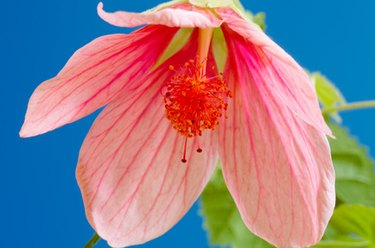Things You'll Need
Abutilon seeds
Potting soil
Planting cell/tray
Water tray/rimmed cookie tin
Bottom-heat source (optional)
Water
or
Parent plant to supply cuttings
Knife, utility knife or razor blade
Potting sand
Planting cell/tray
Watering tray such as rimmed cookie tin
Rooting hormone
Transparent hood or plastic tent
Bottom-heat source

Abutilons are a group of plants in the mallow family, related to hibiscus. They are a tropical to subtropical plant, hardy outdoors only in USDA zones nine to 11. A blossoming plant with flowers in a number of forms, ranging from hibiscus-like to the more characteristic bell-shaped, they are often called Flowering Maple for their bloom and the shape of their leaves. Commonly grown as houseplants, they are easily grown from seed in spring or by stem cuttings in spring and summer.
Growing With Seed
Step 1
Moisten potting soil lightly, until damp but not saturated.
Video of the Day
Step 2
Fill planting cells with potting soil.
Step 3
Place one seed in each cell or tray section. Cover lightly with a thin layer of potting soil.
Step 4
Place cells or trays on watering tray.
Step 5
Place potted seeds with watering tray in a strong, indirect light such as light from a north window, or under a grow light.
Step 6
If using a bottom-heat source such as a planter's heating pad, or a radiator, the desired temperature will be approximately 65 to 75 degrees F.
Step 7
Mist cells, and water from below once a week.
Growing With Cuttings
Step 1
Dampen potting sand and fill cells.
Step 2
Remove three- to four-inch cuttings from the tips of growing branches, cutting at a slight angle just under a leaf node.
Step 3
Remove the leaves at the lowest node without scraping away the base of the node. Root growth can begin from these nodes. Remove additional lower leaves, but leave top growth intact. Ideally as many as three nodes will be available on the lower stem.
Step 4
Dip cutting in rooting hormone in accordance with product directions.
Step 5
Make a hole in the potting soil with your finger. Insert the stem up to the highest exposed node on the stem. Press sand firmly around stem.
Maintaining Humidity
Step 1
Place cells or planting trays on the watering tray. Mist cuttings and add water to one-quarter inch in the watering tray.
Step 2
Place a clear hood or transparent tent over the cells and watering tray.
Step 3
Place the entire unit on the bottom-heating source such as a planter's heating pad or a radiator in indirect light. Optimal temperatures are between 65 to 75 degrees F.
Step 4
Check water twice a week, but expect to water only once.
Step 5
Mist only if there are signs of dried, rather than wilted foliage: the hood or tent should suffice to maintain the high humidity needed for the cuttings.
Tip
It is not necessary to abrade or soak abutilon seeds prior to planting, but it can speed germination.
Germination may take as much as four to five days.
If possible, provide some ventilation to the hood or tenting over cuttings. High humidity is desired. Mold is not.
Warning
Mold is one of the most likely problems with cuttings. Because the humidity must be high, mold also flourishes. One of the best options if you cannot provide some form of air circulation within your hood or tent is to remove the tent entirely for a few hours every day or so to allow things to dry out a bit. Keep a close eye on your cuttings, remove any with mold, and never let cuttings touch the hood or tent as that provides a place for water to accumulate and mold and rot to begin.
Video of the Day